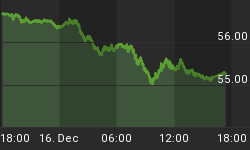Below is an excerpt from a commentary originally posted at www.speculative-investor.com on 20th November 2011.
Relatively rapid inflation of the money supply -- say, a monetary inflation rate averaging 10% per year -- can occur for a long time without the "inflation" becoming "hyper". The reason is that a certain mass psychology must be present to create the condition known as hyperinflation. At the same time, hyperinflation cannot result from psychological factors alone. There must also be rapid growth in the money supply.
To further explain, assume that an economy's money supply has been increasing at around 10% per year for many years, leading to a roughly 8% per year reduction in the purchasing power (pp) of money. (Under normal circumstances the long-term reduction in money pp will be less than the long-term increase in money supply due to the effects of productivity and population increases.) At this point, a critical mass of people comes to believe that the "inflation" will be endless and that money is guaranteed to be worth significantly less in 12 months time than it is today. These people react by becoming much quicker to spend whatever money they get, which has the effect of reducing the pp of money at a faster rate than the money supply is increasing. The accelerated rate at which prices are rising throughout the economy leads to wider recognition of the inflation problem and a more widespread desire to spend money as quickly as possible. In other words, a vicious cycle begins whereby rapid price rises cause people to accelerate their spending, leading to even faster increases in prices, and so on. This is hyperinflation.
The possibility that a change in psychology could accelerate the pace at which money loses pp is why central bankers devote so much time and energy to the management of inflation expectations. However, they need not bother, because the above description of how 'normal' inflation evolves into hyperinflation leaves out a part of the process over which the central bank has full control and without which the general price level could not rocket upward for long. At any time during the inflationary process described above, the central bank could put an end to the price spiral without delving into the nebulous world of psychology. It would simply have to stop the expansion of the money supply.
Consider this: If prices were rising rapidly throughout the economy, a lot more money would be needed for every transaction. Another way of saying this is that the demand for money would be in a steep upward trend. Not the demand for money as a temporary store of purchasing power, but the demand for money as a medium to facilitate exchange.
Now consider what would happen if an upward ramp in money demand were not met by an upward ramp in money supply. It should be clear that a severe shortage of money would soon develop and that the price (purchasing power) of money would rise to bring demand and supply back into balance. That is, the prices of goods and services would fall.
Looking back at historical episodes of hyperinflation we see that when surging prices created an apparent money shortage, the central bank generally responded by increasing the money supply. That is, the central bank continued to feed the inflationary process. It could have stopped the inflation in its tracks at any time by stopping the expansion of the money supply, but for whatever reason it invariably made more sense to those in charge to satisfy the perceived short-term need for more money.
So, not only is substantial growth in the money supply needed to set the stage for hyperinflation, monetary inflation must ramp up with prices in order for an upward price spiral to be sustained beyond the very short-term.
In summary, hyperinflation is not a purely psychological phenomenon. It is also not solely related to changes in the money supply, because there is no telling how much monetary inflation it will take to bring about the frenzied mass shift out of cash that pushes the economy from "inflation" to "hyperinflation". Instead, hyperinflation has psychological and money-supply components. Both are essential.
We aren't offering a free trial subscription at this time, but free samples of our work (excerpts from our regular commentaries) can be viewed at: http://www.speculative-investor.com/new/freesamples.html
















